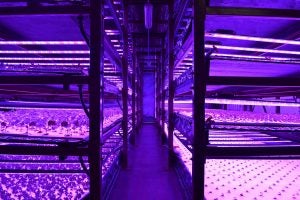Vertical farming has been getting a lot of attention lately. It is being called everything from the “future of agriculture,” to the next driver of ag investment, to the solution to a warming planet. It’s almost as if it’s going to solve all of our future farming needs.
But that’s not the truth.
Vertical farming, and indoor farming more generally, isn’t the be-all and end-all solution to everything facing the industry. It’s true that it can be capital intensive, rent dependent, and not suitable for all types of crops. But indoor farming is about more than that. It is a component of an agricultural system that’s becoming more innovative and more technology-focused every day.
At its most basic level, agriculture is a system that needs to feed a lot of people very efficiently. Right now, we have a pretty efficient system, if you look at just calories produced.
However, not all calories are equal. A large portion of corn is grown to create biofuels, we see massive challenges with food waste, and inaccessibility leads to hunger around the world. So we need to think about where we can increase efficiencies throughout the food system. Can we start relying less and less on water and land in the production of our food? Second, we need our food to be healthier, safer, and all-around better for the consumer. We know that we can grow things that are calorie-intensive, but can we also make sure they are good for us? What’s more, can we grow things in a more food-safe and secure way?
For example, can we grow lettuce in a way such as we don’t have to worry about listeria and E. coli contamination? Can we become less dependent on fertilizers? Can we do things in a more climate-independent way? Can we take a lot of the risk out of the operating side, that conventional farmers are subject to, in order to focus less on seasonality and unpredictability and more on producing healthy, tasty food at scale?

Part of the solution
This is where indoor agriculture and vertical farming can play a really interesting role in the system.
These technologies are never going to entirely replace traditional farms, but there are certain crops that grow really, really well indoors and are well-suited to these growing methods. These are things that have shorter growth cycles and are highly perishable, so you can grow closer to the point of consumption and cut out the inefficiencies on the logistics and delivery side. I’m talking about crops like tomatoes, peppers, cucumbers, traditionally grown in greenhouses, and lettuces, herbs, microgreens, and berries, which are being grown more and more in vertical applications.
It’s true we’re relatively limited in terms of what can be produced indoors right now, but the implications even of just these few crops could be significant. Moving to indoor production for the crops I mentioned would free up hundreds of thousands of acres of land for crops that do better outdoors, such as wheat and other cereals, while simultaneously saving water and other resources for those products. We just need to convince more farmers of the value of these technologies.
We know this will work, because we’ve already seen it happen. With tomatoes.
A question of efficiency
Two things that farmers are focused on are profitability and efficiency.
If you look at tomatoes, 20 to 30 years ago almost all production was done via soil farming. But then, by the turn of the century, attitudes started to change and almost overnight we started to see a lot of new greenhouse producers start offering tomatoes, and it just took off. Today, 37 percent of all fresh tomatoes sold in U.S. retail stores are now hothouse (or greenhouse) production, up from almost zero in the early 1990s.
What happened? Farmers noticed that indoor tomato production was simply more efficient than outdoor and made the switch. Need proof? According to the USDA, the average yield of conventionally grown tomatoes in 2016 was 1.85 pounds per square foot. Greenhouse hydroponic tomato growers, on the other hand, reported an average yield of 10.59 pounds per square foot. Similarly, the average yield of conventionally grown head, leaf, and romaine lettuce is 0.69 pounds per square foot, compared with 8.71 pounds per square foot for leafy greens grown in a greenhouse.
Almost everything in our agricultural system is about efficiency, and indoor farming is nothing more that a tool in the farmer’s toolbox that will help them in their search for new efficiencies.
Looking ahead
The population is becoming more urbanized and we’re going to have a lot more mouths to feed over the next few decades; that much we know for sure. The indoor farming industry has been predominantly dominated by greenhouse crop production in the past but now, due to decreases in technology costs and an increase in local demand for food, we’re seeing an increase in alternate growing systems, particularly fully enclosed vertical systems. With that in mind, I expect to see a lot of crop production where efficiency gains can be had — such as herbs, lettuces, and berries — start to switch to indoor production in the near term.
But I really think that vertical farming, and indoor farming in general, are simply going to be tools that help farmers do more with less. This isn’t the first step into some sort of dystopian society where all of our food is grown in laboratories. It’s a new and exciting component to the food system that will help the industry scale for the future.
Allison Kopf is the Founder and CEO of Agrilyst, an intelligence platform for indoor farms and winner of Techcrunch Disrupt 2015.



